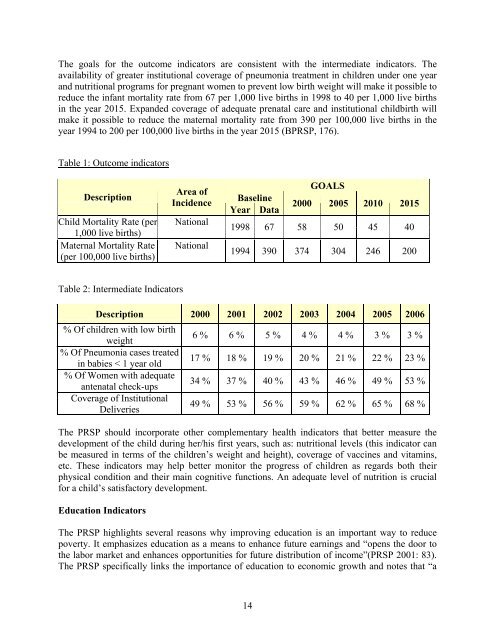Assessing the impact of PRSPs on Child Poverty: The Case of Bolivia
Assessing the impact of PRSPs on Child Poverty: The Case of Bolivia
Assessing the impact of PRSPs on Child Poverty: The Case of Bolivia
Create successful ePaper yourself
Turn your PDF publications into a flip-book with our unique Google optimized e-Paper software.
<strong>The</strong> goals for <str<strong>on</strong>g>the</str<strong>on</strong>g> outcome indicators are c<strong>on</strong>sistent with <str<strong>on</strong>g>the</str<strong>on</strong>g> intermediate indicators. <strong>The</strong><br />
availability <str<strong>on</strong>g>of</str<strong>on</strong>g> greater instituti<strong>on</strong>al coverage <str<strong>on</strong>g>of</str<strong>on</strong>g> pneum<strong>on</strong>ia treatment in children under <strong>on</strong>e year<br />
and nutriti<strong>on</strong>al programs for pregnant women to prevent low birth weight will make it possible to<br />
reduce <str<strong>on</strong>g>the</str<strong>on</strong>g> infant mortality rate from 67 per 1,000 live births in 1998 to 40 per 1,000 live births<br />
in <str<strong>on</strong>g>the</str<strong>on</strong>g> year 2015. Expanded coverage <str<strong>on</strong>g>of</str<strong>on</strong>g> adequate prenatal care and instituti<strong>on</strong>al childbirth will<br />
make it possible to reduce <str<strong>on</strong>g>the</str<strong>on</strong>g> maternal mortality rate from 390 per 100,000 live births in <str<strong>on</strong>g>the</str<strong>on</strong>g><br />
year 1994 to 200 per 100,000 live births in <str<strong>on</strong>g>the</str<strong>on</strong>g> year 2015 (BPRSP, 176).<br />
Table 1: Outcome indicators<br />
Descripti<strong>on</strong><br />
<strong>Child</strong> Mortality Rate (per<br />
1,000 live births)<br />
Maternal Mortality Rate<br />
(per 100,000 live births)<br />
Table 2: Intermediate Indicators<br />
Descripti<strong>on</strong> 2000 2001 2002 2003 2004 2005 2006<br />
% Of children with low birth<br />
weight<br />
6 % 6 % 5 % 4 % 4 % 3 % 3 %<br />
% Of Pneum<strong>on</strong>ia cases treated<br />
in babies < 1 year old<br />
17 % 18 % 19 % 20 % 21 % 22 % 23 %<br />
% Of Women with adequate<br />
antenatal check-ups<br />
34 % 37 % 40 % 43 % 46 % 49 % 53 %<br />
Coverage <str<strong>on</strong>g>of</str<strong>on</strong>g> Instituti<strong>on</strong>al<br />
Deliveries<br />
49 % 53 % 56 % 59 % 62 % 65 % 68 %<br />
<strong>The</strong> PRSP should incorporate o<str<strong>on</strong>g>the</str<strong>on</strong>g>r complementary health indicators that better measure <str<strong>on</strong>g>the</str<strong>on</strong>g><br />
development <str<strong>on</strong>g>of</str<strong>on</strong>g> <str<strong>on</strong>g>the</str<strong>on</strong>g> child during her/his first years, such as: nutriti<strong>on</strong>al levels (this indicator can<br />
be measured in terms <str<strong>on</strong>g>of</str<strong>on</strong>g> <str<strong>on</strong>g>the</str<strong>on</strong>g> children’s weight and height), coverage <str<strong>on</strong>g>of</str<strong>on</strong>g> vaccines and vitamins,<br />
etc. <strong>The</strong>se indicators may help better m<strong>on</strong>itor <str<strong>on</strong>g>the</str<strong>on</strong>g> progress <str<strong>on</strong>g>of</str<strong>on</strong>g> children as regards both <str<strong>on</strong>g>the</str<strong>on</strong>g>ir<br />
physical c<strong>on</strong>diti<strong>on</strong> and <str<strong>on</strong>g>the</str<strong>on</strong>g>ir main cognitive functi<strong>on</strong>s. An adequate level <str<strong>on</strong>g>of</str<strong>on</strong>g> nutriti<strong>on</strong> is crucial<br />
for a child’s satisfactory development.<br />
Educati<strong>on</strong> Indicators<br />
Area <str<strong>on</strong>g>of</str<strong>on</strong>g><br />
Incidence<br />
Nati<strong>on</strong>al<br />
Nati<strong>on</strong>al<br />
Baseline<br />
Year Data<br />
<strong>The</strong> PRSP highlights several reas<strong>on</strong>s why improving educati<strong>on</strong> is an important way to reduce<br />
poverty. It emphasizes educati<strong>on</strong> as a means to enhance future earnings and “opens <str<strong>on</strong>g>the</str<strong>on</strong>g> door to<br />
<str<strong>on</strong>g>the</str<strong>on</strong>g> labor market and enhances opportunities for future distributi<strong>on</strong> <str<strong>on</strong>g>of</str<strong>on</strong>g> income”(PRSP 2001: 83).<br />
<strong>The</strong> PRSP specifically links <str<strong>on</strong>g>the</str<strong>on</strong>g> importance <str<strong>on</strong>g>of</str<strong>on</strong>g> educati<strong>on</strong> to ec<strong>on</strong>omic growth and notes that “a<br />
14<br />
GOALS<br />
2000 2005 2010 2015<br />
1998 67 58 50 45 40<br />
1994 390 374 304 246 200



